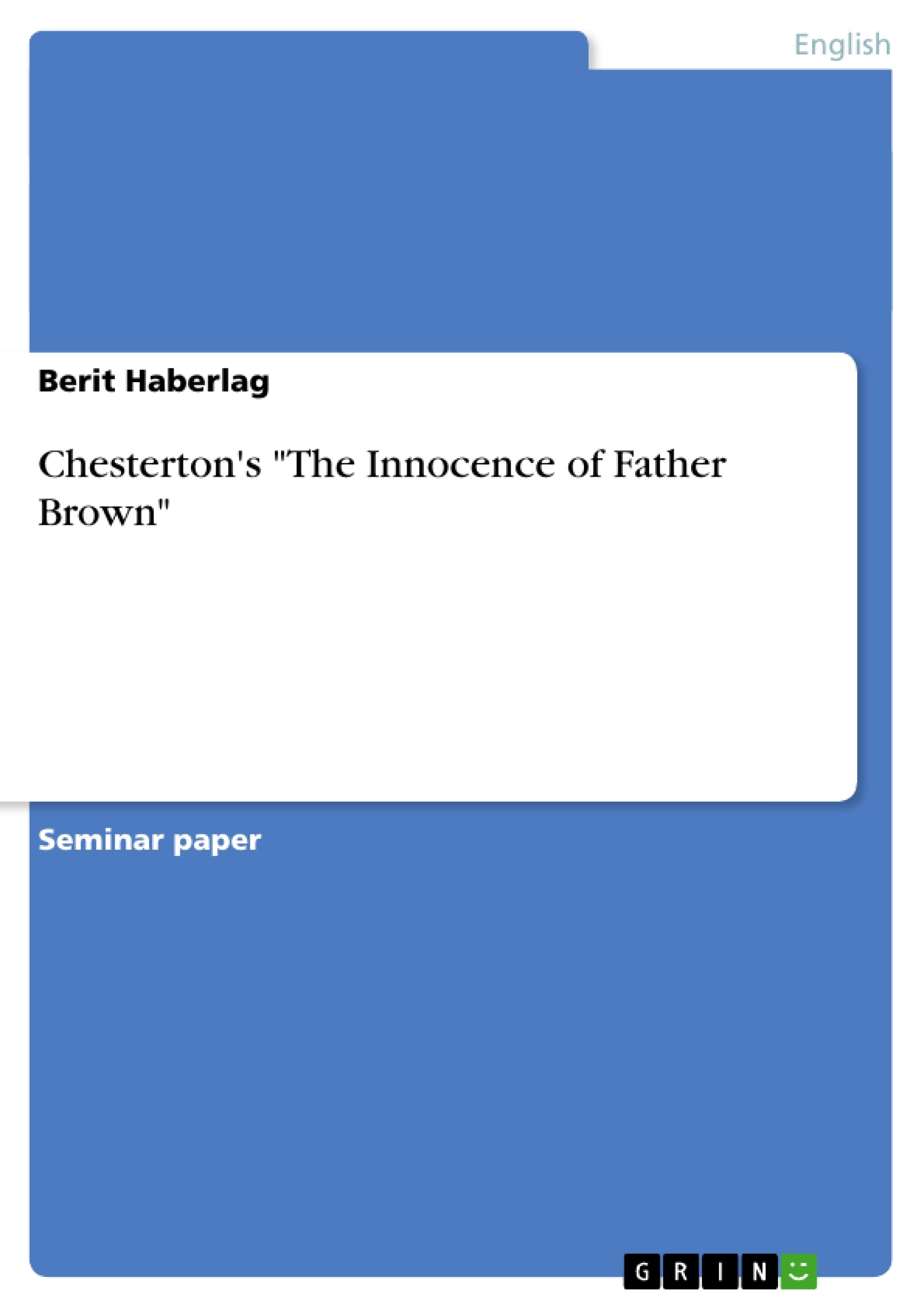Gilbert Keith Chesterton started writing when he was still very young. He published hundreds of books and essays. His work consists of novels, short stories, poems and biographies.
But today he is only known for his Father Brown stories and they are also the most widely read stories of all Chesterton’s writing. Furthermore, they are the form of art in which he was most successful. You can call them his masterpiece. The Father Brown Stories consist of five books. Two of them are pre-War. They “constitute a fascinating summary of Chesterton practising what he preached” (Hunter 1983, p.140).
The first book of the Father Brown Stories is “The Innocence of Father Brown” consisting of twelve stories dealing with Father Brown. Then there is the “The Wisdom of Father Brown”, “The Incredulity of Father Brown”, “The Secret of Father Brown” and “The Scandal of Father Brown”.
All these books were published between 1911 and 1935.
In my work I will concentrate on the first collection of Father Brown Stories, “The Innocence of Father Brown” which was published in 1911 and was dedicated to Chesterton’s old friend Waldo D’Avigdor and his wife Mildred.
From this collection I chose three stories (“The Queer Feet”, “The Hammer of God” and “The Sins of Prince Saradine”).
I will give a summary of them and then I will compare them to find out differences or what is the same. After that I will talk about some striking elements in “The Innocence of Father Brown”.
As Father Brown is the only character that counts in the Father Brown Stories I will characterise him and later on write of his attitudes and role in this book. With the help of what I found out, I will try to explain the title of “The Innocence of Father Brown”.
Inhaltsverzeichnis (Table of Contents)
- Introduction
- Summaries
- The Queer Feet
- The Hammer of God
- The Sins of Prince Saradine
- The Innocence of Father Brown
- Comparison of the three stories
- Striking Elements in “The Innocence of Father Brown”
- Father Brown
- Characterisation of Father Brown
- Father Brown in \"The Innocence of Father Brown\"
- The title \"The Innocence of Father Brown\"
- Bibliography
Zielsetzung und Themenschwerpunkte (Objectives and Key Themes)
This paper explores Gilbert Keith Chesterton's first collection of Father Brown Stories, "The Innocence of Father Brown," published in 1911. It delves into three specific stories from this collection, analyzing their narratives and comparing their elements. The paper further examines the character of Father Brown, his role in the stories, and the broader themes that contribute to the book's title. The primary goal is to understand the complexities of Chesterton's writing and how it resonates within the context of the detective story genre.
- The portrayal of Father Brown as a detective and his unique methods of investigation.
- The exploration of religious themes and the role of faith in solving crimes.
- The juxtaposition of innocence and guilt, highlighting the complexities of human nature.
- The use of irony and paradox to create a captivating and thought-provoking reading experience.
- The analysis of how Chesterton's storytelling style contributes to the overall impact of the Father Brown stories.
Zusammenfassung der Kapitel (Chapter Summaries)
The paper starts with an introduction, providing background information on Gilbert Keith Chesterton and his Father Brown Stories. The introduction outlines the scope of the paper, focusing on the first collection, "The Innocence of Father Brown," and three specific stories: "The Queer Feet," "The Hammer of God," and "The Sins of Prince Saradine."
The second chapter presents summaries of the selected stories, focusing on key events and character interactions. "The Queer Feet" centers on Flambeau's attempt to steal silverware from the members of the Twelve True Fishermen at the Vernon Hotel. The story highlights Father Brown's unusual observation skills and his unconventional approach to solving the crime. "The Hammer of God" introduces the murder of Norman Bohun and its impact on his devout brother, Wilfrid. The story hints at the complexities of faith and the challenges of dealing with personal tragedy.
The third chapter then delves into a comparison of the three stories, examining their similarities and differences. It analyzes how Chesterton utilizes recurring themes and narrative techniques in each story, contributing to the overall characterization of Father Brown and the unique atmosphere of the Father Brown universe. The chapter concludes with a discussion of the striking elements that define "The Innocence of Father Brown," highlighting the stylistic choices that contribute to its lasting impact on the genre.
Schlüsselwörter (Keywords)
The paper focuses on the Father Brown stories, Gilbert Keith Chesterton, detective fiction, religious themes, character analysis, narrative techniques, irony, paradox, innocence, guilt, and the concept of "The Innocence of Father Brown" as a central theme.
- Citation du texte
- Berit Haberlag (Auteur), 2004, Chesterton's "The Innocence of Father Brown", Munich, GRIN Verlag, https://www.grin.com/document/41257



